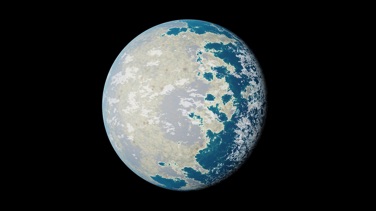TRAPPIST-1d is the third closest planet to the star, orbiting in a near-circular orbit at a distance of only 3.21 million km (0.021 AU). The smallest planet, it is approximately 41% the mass of the Earth and 23% smaller in radius, making it somewhat larger than Mars. It has a density slightly lower than Earth’s, suggesting a silicate rocky composition similar to Earth, but with a slightly smaller iron core. It receives 1.14 times more solar irradiance than Earth, giving it a mean surface temperature of 288 K (15°C). Like Mars, its low gravity would have trouble retaining an atmosphere. Therefore it is not likely to be habitable.
The star’s size as viewed from the surface of TRAPPIST-1d would be 2.9 degrees across, about 6 times larger than we see our own Sun. The planet is tidally locked to its star, keeping the same face towards it at all times. For a visitor to the sunward side of the planet, the dull red sun would hang in place, neither rising nor setting. The two inner planets would regularly cross the sky, probably transiting (but not eclipsing) the sun’s disk each time, and occulting one another. At solar conjunction, the closer one, TRAPPIST-1c would appear more than one-and-a-half times as large as our moon does from Earth. On the opposite side of the planet, it would be perpetually dark, broken only by the other four planets racing across the sky, regularly passing near or in front of one another. Unlike our Solar System, the other TRAPPIST-1 planets are close enough to show as small disks, even with naked eyes. At closest approach, the next planet out, TRAPPIST-1e would cover 0.67 degrees, a third larger than the moon does from Earth. Meanwhile, the distant stars would rise in the east and cross the sky to set in the west slower than they do on Earth. With a year only 4.05 Earth-days long, the entire celestial sphere would be observable every 97 hours!
